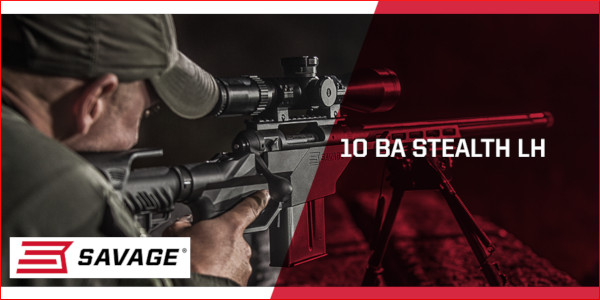Big News — Savage Arms Sold Off by Vista Outdoor

Big news for the shooting community! Just six years after it acquired Savage Arms, outdoor industry mega-corp Vista Outdoor is selling off Savage Arms. The firearms-maker will be acquired by a private investment group led by Savage’s current management. When the sale is complete, Vista Outdoor, parent company of dozens of outdoor brands such as Bushnell, Bell Helmets, CCI, Camelback, Federal, RCBS, and Weaver, will no longer produce firearms of any kind. The sell-back to the Savage management group will include Stevens Arms*, which primarily produces shotguns.
There were multiple reasons given for the sale, which include:
1. Cutting costs, reducing corporate debt, and consolidating operations at Vista Outdoor.
2. Focusing more on the ammunition brands Alliant, CCI, Speer, and Federal.
3. Giving Vista Outdoor’s “ammunition brands flexibility to work with any industry partner”.
In addition, we suspect that, given the current political climate and media antagonism towards gun-makers, Vista Outdoor’s leadership deemed that owning Savage was bad for the company’s overall image. The potential profits from Savage were simply not worth the negative press as well as the potential liabilities from gun-related lawsuits.
By the Numbers: Vista Outdoor acquired Savage Arms (and Stevens) in July 2013 for $315 million. The July 2019 sell-off of Savage Arms (and Stevens) for $170 million represents a $145 million loss for Vista Outdoor. That’s not a good business model.

Founded in 1894, Massachusetts-based Savage Arms is one of America’s oldest gun-makers. While it has produced a wide variety of firearms over the past 125 years, Savage is now best known for its affordable bolt-action hunting rifles that feature barrels attached by a barrel-nut. In recent years, Savage has also moved aggressively into the “black rifle” market producing its MSR series of AR-platform rifles in a variety of chamberings. Savage also produces a popular semi-auto Rimfire rifle, the Savage A17/A22 series.

Here is the official Press Release covering Vista Outdoor’s sale of Savage Arms to a group of investors headed by Al Kasper, Savage’s President and CEO (emphasis added):
Vista Outdoor Announces Sale of Savage Brand
Vista Outdoor Inc. (“Vista Outdoor”) (NYSE: VSTO) announced today that it has completed the sale of the legal entity operating its Savage Arms and Stevens firearms brands to a financial buyer for a total purchase price of $170 million, comprised of $158 million paid at closing and $12 million to be paid upon maturity of a five-year seller note issued by the buyer to Vista Outdoor in connection with the transaction.The sale is part of Vista Outdoor’s previously announced transformation plan, which outlined the intent to reshape the company’s portfolio by cutting costs, consolidating leadership, paying down debt, and divesting certain brands, including both its eyewear brands and firearms brands, in order to pursue growth in product categories where the company believes it can be market leaders. As the company now looks forward, the focus is on ammunition, hunting and shooting accessories, hydration bottles and packs, outdoor cooking products, and cycling/ski helmets and accessories.
“Divesting our Savage brand was a key aspect of our transformation plan,” said Chris Metz, CEO of Vista Outdoor. “While it was a difficult decision to sell such an iconic brand, I remain confident that this was the correct choice to help Vista Outdoor grow in those categories where we can have leadership positions. Savage is a fantastic business, and it deserves to continue to evolve into other firearms categories. At this time, however, we simply do not have the resources to transform Savage into the full-service firearms company that it deserves to be and, therefore, we determined the brand would be better off with a different owner. We’re excited to see Savage reach its full potential under new ownership.”
Savage was acquired by Vista Outdoor’s predecessor, ATK, in 2013. ATK’s sporting business – which included Savage, Bushnell, Federal and CCI Ammunition, and dozens of other hunt/shoot accessories brands, spun off in 2015 to become Vista Outdoor.
“The Savage acquisition helped create Vista Outdoor, and we’re grateful for all the success the brand brought to our company over the past six years,” said Metz. “However, this divestiture now gives our ammunition brands flexibility to work with any industry partner to create the best products and meet our consumers’ needs.”
At closing, Vista Outdoor received gross proceeds from the divestiture of $158 million. Vista Outdoor will use the net after-tax proceeds of the sale to repay outstanding indebtedness.
“Reducing our debt is a key part of turning around our business,” said Metz. “Selling Savage and further reducing our overall leverage will improve our financial flexibility and better position the company for long-term growth. We’ve now rebuilt the company’s foundation to provide a more stable base upon which to grow. We have a portfolio of brands that all have the potential to be strong, market leaders in their respective categories and I’m proud of my team’s efforts in reshaping the portfolio over the course of the past year.”
*American firearms manufacturer J. Stevens Arms & Tool Company, now part of Savage Arms, introduced the .22 Long Rifle cartridge in 1887. Savage Arms was founded in 1894 by Arthur Savage in Utica, New York. Within 20 years Savage was producing rifles, handguns, and ammunition. Savage introduced the first hammerless lever-action rifle, the Model 1895, derived from Arthur Savage’s Model 1892 rifle that he had designed for Colt.
Story tip from EdLongrange. We welcome reader submissions.
















 He who dies with the most toys wins — right? Well Sinclair has another interesting gadget you can add to your reloading bench. The Sinclair
He who dies with the most toys wins — right? Well Sinclair has another interesting gadget you can add to your reloading bench. The Sinclair 




